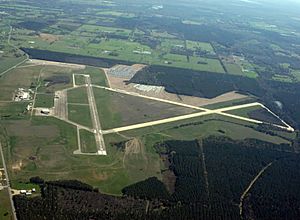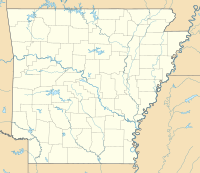Hope Municipal Airport facts for kids
Quick facts for kids
Hope Municipal Airport
|
|||||||||||||||
|---|---|---|---|---|---|---|---|---|---|---|---|---|---|---|---|
 |
|||||||||||||||
| Summary | |||||||||||||||
| Airport type | Public | ||||||||||||||
| Owner | City of Hope | ||||||||||||||
| Serves | Hope, Arkansas | ||||||||||||||
| Location | Hempstead County | ||||||||||||||
| Elevation AMSL | 359 ft / 109 m | ||||||||||||||
| Coordinates | 33°43′12″N 093°39′32″W / 33.72000°N 93.65889°W | ||||||||||||||
| Map | |||||||||||||||
| Runway | |||||||||||||||
|
|||||||||||||||
| Statistics (2010) | |||||||||||||||
|
|||||||||||||||
|
Source: Federal Aviation Administration
|
|||||||||||||||
Hope Municipal Airport (M18) is a public airport in Hope, Arkansas. It is owned by the city of Hope. The airport is located about 7 kilometers (5 miles) northwest of the city center. It is mainly used for general aviation, which means it handles smaller planes, not large passenger jets.
After Hurricane Katrina hit in 2005, Hope Municipal Airport was used as a storage area. Thousands of travel trailers and mobile homes were kept there. These homes were meant for people who had lost their houses in the hurricane.
Contents
Airport History
Hope Municipal Airport has a very interesting past. It played an important role during World War II.
World War II Era
During World War II, the airport was known as the Southwestern Proving Ground (SWPG). It was a special place where the US military tested artillery shells and air bombs. It also served as an airfield for bombers. The proving ground operated from 1941 to 1945. It provided many jobs for people in the surrounding counties.
The US government started building the SWPG in 1941. This was part of a plan to prepare for the war. They needed to make sure they had enough factories for weapons, planes, and tanks. To build the proving ground, the government bought a lot of land. About 404 families had to move from their homes.
The Callahan Construction Company built the proving ground. They hired about 4,000 workers. When the airport was finished, it had one of the longest runways in the United States. Its opening celebration was delayed because of the attack on Pearl Harbor in December 1941.
Testing and Research
Testing at the SWPG began in January 1942. Soldiers used special tools to check the accuracy of weapons. For example, they found out that some 105-mm shells had problems. This research helped save the lives of American troops. B-25 planes also flew from Hope to the Gulf of Mexico. They observed how bombs worked after being fired. After World War II ended, the city of Hope took over the airport. It officially became Hope Municipal Airport in 1947.
Historic Buildings
Some of the old buildings at the airport are now part of a special historic area. This area is called the Southwestern Proving Ground Airport Historic District. It was added to the National Register of Historic Places in 2008. The district includes six buildings and five other structures.
Key Structures
The main building is a large hangar. It is made of brick and has a unique curved roof. The hangar covers about 2,322 square meters (25,000 square feet). It was used to store and work on aircraft.
Near the hangar is the night landing plant. This is a simple, one-story brick building. It helped with operations during nighttime landings.
Across the road from the hangar is the steam heating plant. This building used to create steam heat for all the buildings in the complex. Today, it houses an education center.
Other historic buildings include a storage building and two buildings on private land: the bomb assembly building and the high explosives magazine. Bombs were put together in the assembly building. Then they were taken by truck to Louisiana for testing.
Airport Facilities
Hope Municipal Airport covers a large area of about 637 hectares (1,575 acres). It is located 109 meters (359 feet) above sea level.
The airport has two main runways. Both runways have concrete surfaces.
- Runway 4/22 is 1,695 meters (5,560 feet) long and 46 meters (150 feet) wide.
- Runway 16/34 is 1,677 meters (5,501 feet) long and 46 meters (150 feet) wide.
In 2010, the airport had about 8,000 aircraft operations. This means planes took off or landed about 21 times each day. Most of these operations (94%) were for general aviation. The remaining 6% were for military planes. At that time, 26 aircraft were based at the airport. Most of them were single-engine planes.


